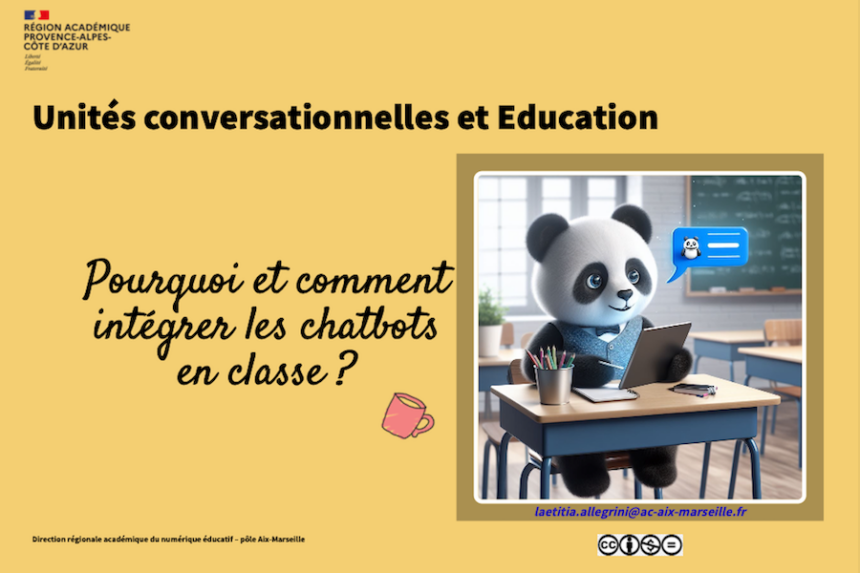For the past two years, this « possible » technological revolution has been challenging the teaching world and could change our pedagogical practices. Conversational units or chatbots could be an innovative tool to implement in educational scenarios. These new tools might meet certain needs such as assisting the teacher in their work, differentiating, supporting, and accompanying the student in skill-building, etc.
These aids can become a powerful and innovative educational tool that ensures inclusive learning. During this workshop, I will try to answer this question: « Why and how to integrate chatbots, conversational units in the classroom? »
After a general presentation, I will highlight during this collaborative workshop the objectives, the teacher’s role, and the tools for implementing conversational units in an educational scenario. Participants will be able to test chatbots and envision a creation process and consider using them in their daily life and/or that of their students.
Contribution of Digital Technology:
Conversational units, if defined, simulate human conversations. Chatbots can be found on various digital platforms such as computers, tablets, and phones, and in different forms: links, QR codes, bubbles, integration into a web page.
Their essence allows the teacher to propose their use before, during, or after a class session. This varied digital form also allows for a wide range of activities (role-playing, gamification, simulation of conversations in language activities, tutoring, exercisers, methodology, etc.) accessible to the greatest number to ensure equity. Their form also provides additional motivation for the student. The student experience, based on simplified and innovative use, promotes the construction or consolidation of learning.
Relationship with the Theme of the Edition:
Conversational units are increasingly present in our daily lives as citizens. We even see integrated chatbots in browsers such as Copilot, Bard, etc. They will surely be increasingly present in our pedagogical practices and their use in the classroom. Chatbots raise questions and must be used with caution and kindness, but they can also provide solutions to certain challenges of our profession and offer an additional inclusive tool. This workshop will show concrete examples of the use of chatbots in the classroom, including their integration into the daily lives of their training.
Summary and Contribution of Classroom Feedback:
I discovered chatbots during an eTwinning project two years ago. Our theme was « The Blob » and our idea was to create a digital escape game on this topic, including statistical math puzzles. On this occasion, we integrated a chatbot that allowed entry into the game. The students’ feedback was very positive, and I questioned the interest of these conversational units in my pedagogical practice. Could they have real value for my students with special educational needs?
At the same time, the DRANE PACA included me in their AI in Education reflection group. Sharing experiences and my questioning led me to experiment with creating chatbots by my students. They then created chatbots to meet specific needs in our school and network following a survey. The creations were diverse: a chatbot guiding visitors on our school’s website, an assistant checking calculations in metalwork, a Mr. Cocktail robot created for the hospitality section of a vocational high school in our network integrated into the cash register of their application restaurant allowing the creation of cocktails.
Enriched by this experience, the CAP Metalwork students are creating conversational units this year, integrated as QR codes on each machine in their workshops. These allow for accompanying the student in their use while respecting safety instructions. From feedback, students memorize procedures better and have developed, in addition to professional skills, digital and cross-disciplinary skills. What is enjoyable in the creation or use of a chatbot is its transposability. It is possible, based on a specific need and precise objectives, to create a suitable chatbot. My presentation shows some examples, ranging from simulating a conversation in a restaurant in English, interviewing a historical figure, to accompanying the use of a microscope, etc.
Integrating chatbots in the educational field could symbolize a future where Artificial Intelligence transforms into an inclusive educational tool, promoting the acquisition of learning.
At the 21st edition of the Ludovia Summer University, numerous teachers and other members of the educational community will present their experiences with digital technology under this year’s theme, « Daily Use of Digital Technology in the Classroom and in Schools. » Ludomag offers you a preview of these workshops until the event begins on Monday, August 26.
Laetitia Allegrini will present the workshop « Why and How to Integrate Chatbots in the Classroom? » during the opening session on Tuesday morning, August 27, and during Session IV: DIGITAL TECHNOLOGY & DAILY LIFE: A CULTURAL AND SOCIETAL CHALLENGE? on Wednesday afternoon, August 28.
More info: www.ludovia.fr








